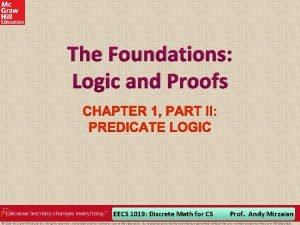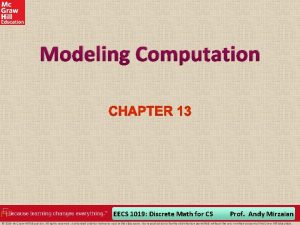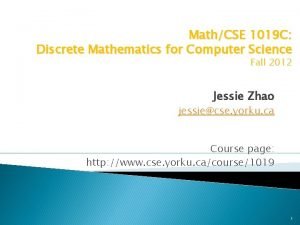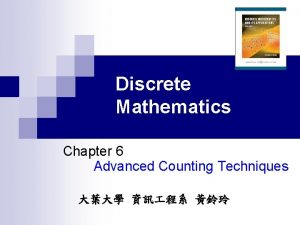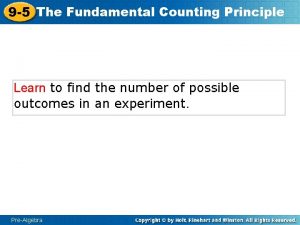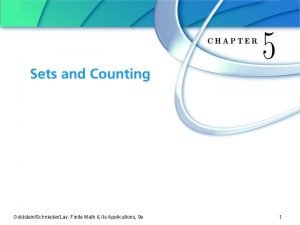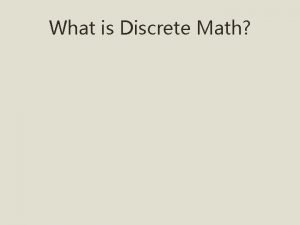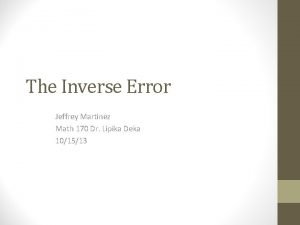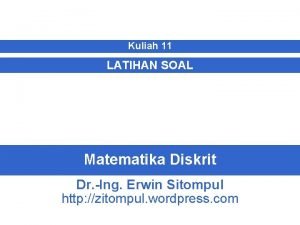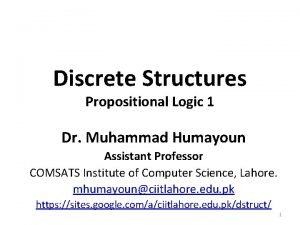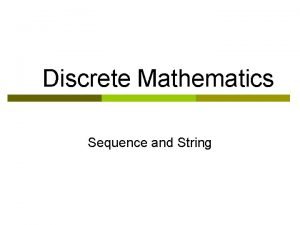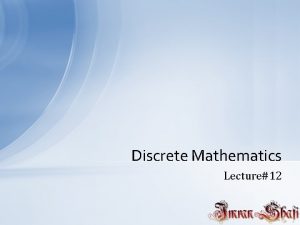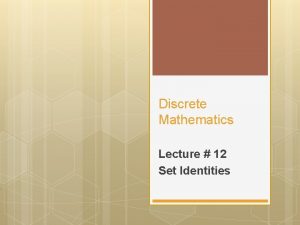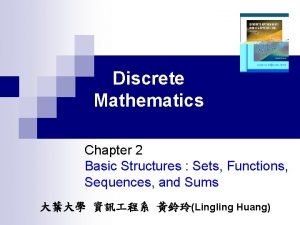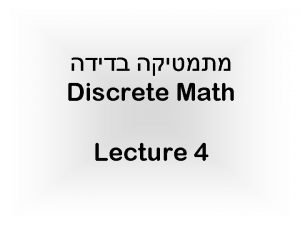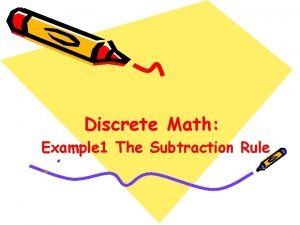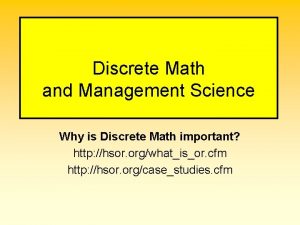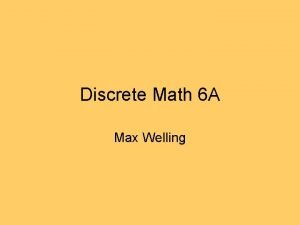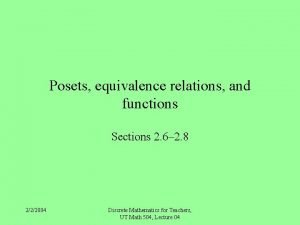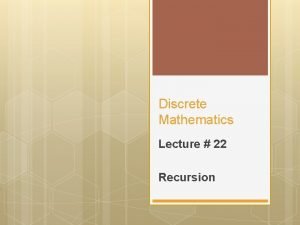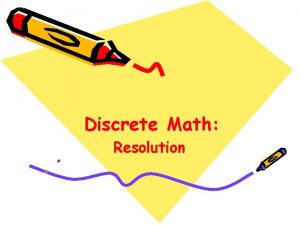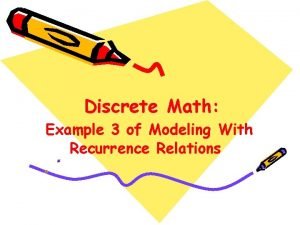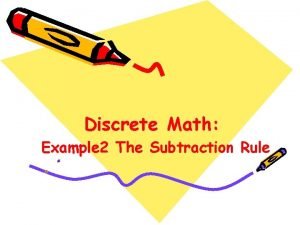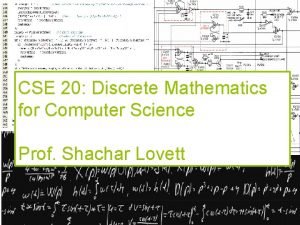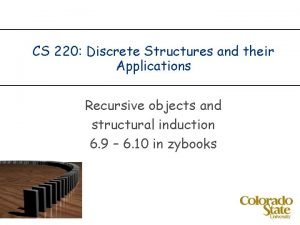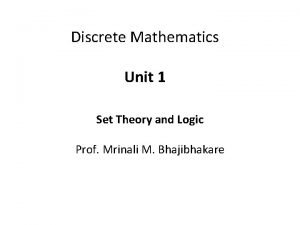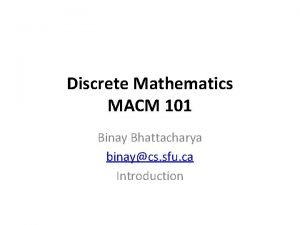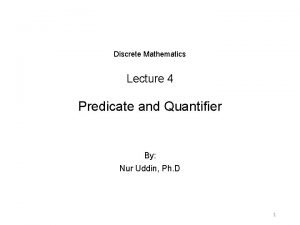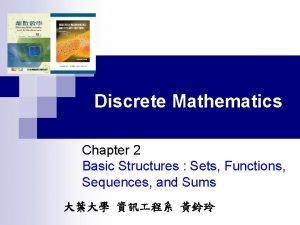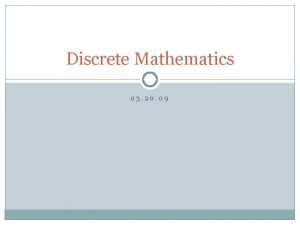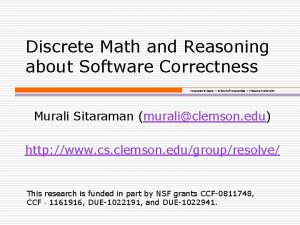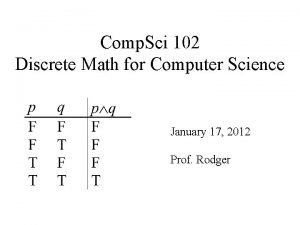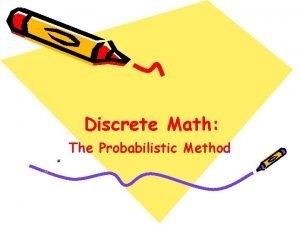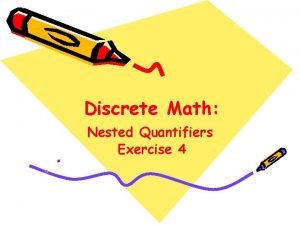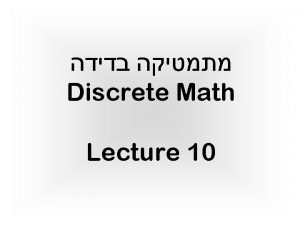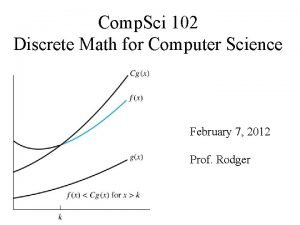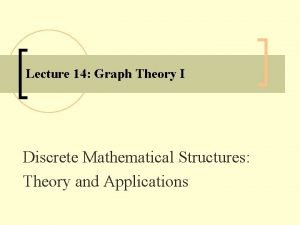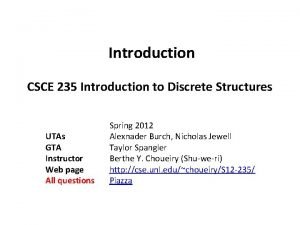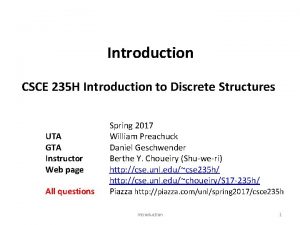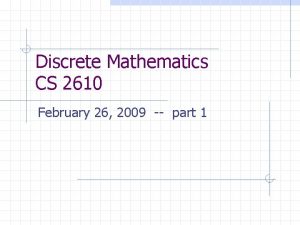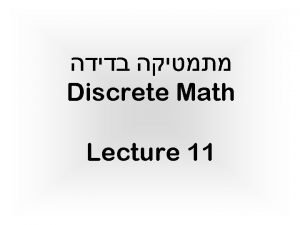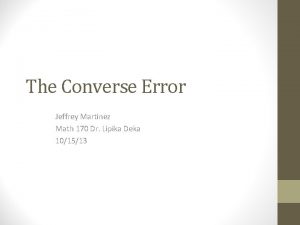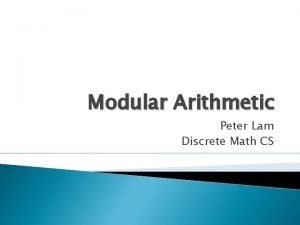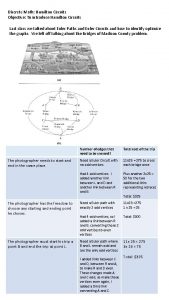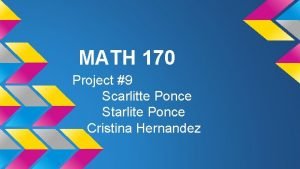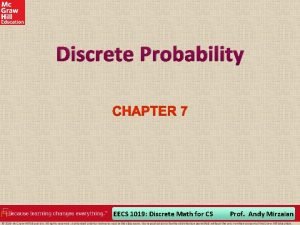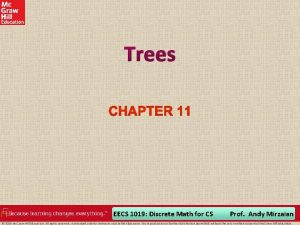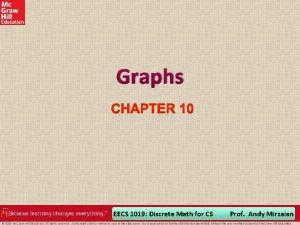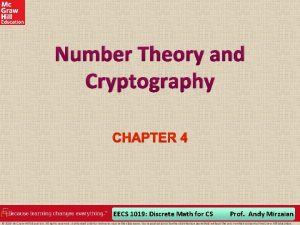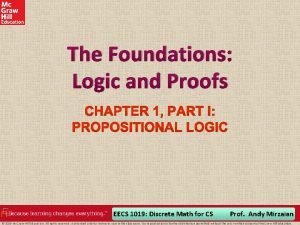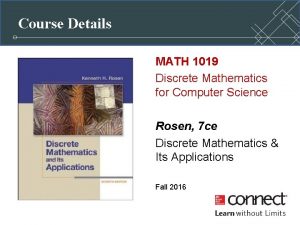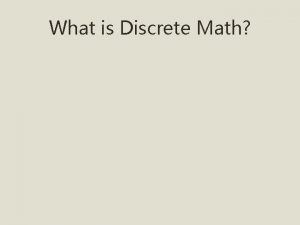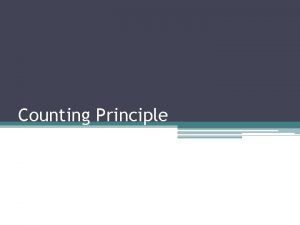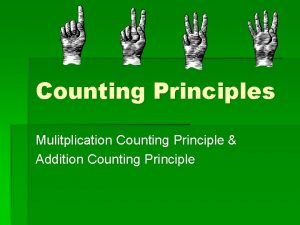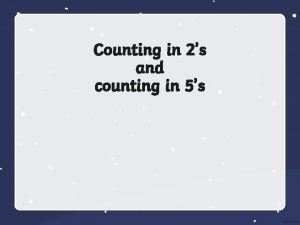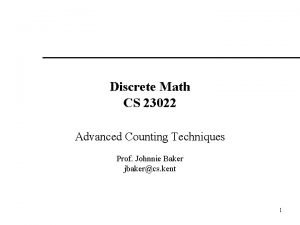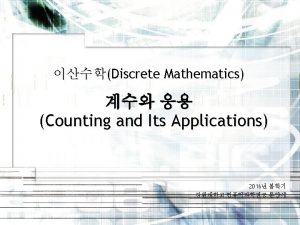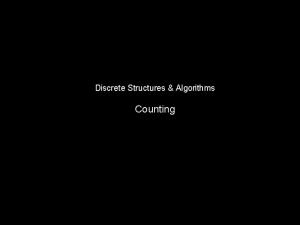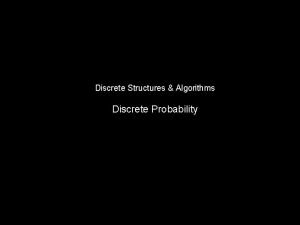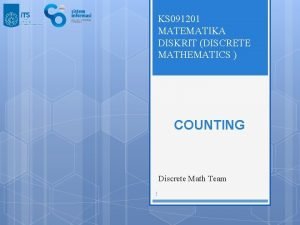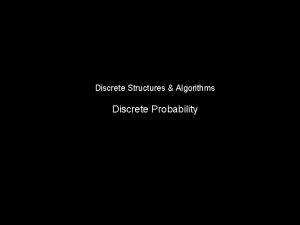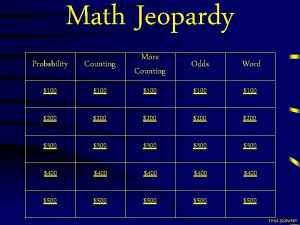Counting EECS 1019 Discrete Math for CS Prof











































































- Slides: 75

Counting EECS 1019: Discrete Math for CS Prof. Andy Mirzaian © 2019 Mc. Graw-Hill Education. All rights reserved. Authorized only for instructor use in the classroom. No reproduction or further distribution permitted without the prior written consent of Mc. Graw-Hill Education.

Chapter Summary • The Basics of Counting • The Pigeonhole Principle • Permutations and Combinations • Binomial Coefficients and Identities • Generalized Permutations and Combinations • Generating Permutations and Combinations (not included) 2 © 2019 Mc. Graw-Hill Education

The Basics of Counting Section 6. 1 3 © 2019 Mc. Graw-Hill Education

Section Summary 1 • The Product Rule • The Sum Rule • The Subtraction Rule • The Division Rule • Examples • Tree Diagrams 4 © 2019 Mc. Graw-Hill Education

Basic Counting Principles: The Product Rule: A procedure can be broken down into a sequence of two tasks. There are n 1 ways to do the first task and n 2 ways to do the second task. Then there are n 1∙n 2 ways to do the procedure. Example: How many bit strings of length seven are there? Solution: Since each of the seven bits is either a 0 or a 1, the answer is 27 = 128. 5 © 2019 Mc. Graw-Hill Education

The Product Rule Example: How many different license plates can be made if each plate contains a sequence of three uppercase English letters followed by three digits? Solution: By the product rule, there are 26 ∙ 10 ∙ 10 = 17, 576, 000 different possible license plates. Jump to long description © 2019 Mc. Graw-Hill Education 6

Counting Functions 7 © 2019 Mc. Graw-Hill Education

Telephone Numbering Plan Example: The North American numbering plan (NANP) specifies that a telephone number consists of 10 digits, consisting of a three-digit area code, a three-digit office code, and a four-digit station code. There are some restrictions on the digits. • • • Let X denote a digit from 0 through 9. Let N denote a digit from 2 through 9. Let Y denote a digit that is 0 or 1. In the old plan (in use in the 1960 s) the format was NYX-NNX-XXXX. In the new plan, the format is NXX-XXXX. How many different telephone numbers are possible under the old plan and the new plan? Solution: Use the Product Rule. • • There are 8 ∙ 2 ∙ 10 = 160 area codes with the format NYX. There are 8 ∙ 10 = 800 area codes with the format NXX. There are 8 ∙ 10 = 640 office codes with the format NNX. There are 10 ∙ 10 = 10, 000 station codes with the format XXXX. Number of old plan telephone numbers: 160 ∙ 640 ∙ 10, 000 = 1, 024, 000. Number of new plan telephone numbers: 800 ∙ 10, 000 = 6, 400, 000. 8 © 2019 Mc. Graw-Hill Education

Counting Subsets of a Finite Set: Use the product rule to show that the number of different subsets of a finite set S is 2|S|. (In Section 5. 1, mathematical induction was used to prove this same result. ) Solution: When the elements of S are listed in an arbitrary order, there is a one-to-one correspondence between subsets of S and bit strings of length |S|. When the ith element is in the subset, the bit string has a 1 in the ith position and a 0 otherwise. By the product rule, there are 2|S| such bit strings, and therefore 2|S| subsets. © 2019 Mc. Graw-Hill Education 9

Product Rule in Terms of Sets 10 © 2019 Mc. Graw-Hill Education

DNA and Genomes A gene is a segment of a DNA molecule that encodes a particular protein and the entirety of genetic information of an organism is called its genome. DNA molecules consist of two strands of blocks known as nucleotides. Each nucleotide is composed of bases: adenine (A), cytosine (C), guanine (G), or thymine (T). The DNA of bacteria has between 105 and 107 links (one of the four bases). Mammals have between 108 and 1010 links. So, by the product rule there at least 4105 different sequences of bases in the DNA of bacteria and 4108 different sequences of bases in the DNA of mammals. The human genome includes approximately 23, 000 genes, each with 1, 000 or more links. Biologists, mathematicians, and computer scientists all work on determining the DNA sequence (genome) of different organisms. 11 © 2019 Mc. Graw-Hill Education

Basic Counting Principles: The Sum Rule: If a task can be done either in one of n 1 ways or in one of n 2, where none of the set of n 1 ways is the same as any of the n 2 ways, then there are n 1 + n 2 ways to do the task. Example: The mathematics department must choose either a student or a faculty member as a representative for a university committee. How many choices are there for this representative if there are 37 members of the mathematics faculty and 83 mathematics majors and no one is both a faculty member and a student. Solution: By the sum rule it follows that there are 37 + 83 = 120 possible ways to pick a representative. 12 © 2019 Mc. Graw-Hill Education

The Sum Rule in terms of sets. The case where the sets have elements in common will be discussed when we consider the subtraction rule and will be taken up fully in Chapter 8. 13 © 2019 Mc. Graw-Hill Education

Combining the Sum and Product Rule Example: Suppose statement labels in a programming language can be either a single letter or a letter followed by a digit. Find the number of possible labels. Solution: Use the sum and product rules. 26 + 26 ∙ 10 = 286 14 © 2019 Mc. Graw-Hill Education

Counting Passwords Combining the sum and product rule allows us to solve more complex problems. Example: Each user on a computer system has a password, which is six to eight characters long, where each character is an uppercase letter or a digit. Each password must contain at least one digit. How many possible passwords are there? Solution: Let P be the total number of passwords, and let P 6, P 7, and P 8 be the passwords of length 6, 7, and 8. • • By the sum rule P = P 6 + P 7 +P 8. To find each of P 6, P 7, and P 8 , we find the number of passwords of the specified length composed of letters and digits and subtract the number composed only of letters. We find that: P 6 = 366 − 266 = 2, 176, 782, 336 − 308, 915, 776 = 1, 867, 866, 560. P 7 = 367 − 267 = 78, 364, 164, 096 − 8, 031, 810, 176 = 70, 332, 353, 920. P 8 = 368 − 268 = 2, 821, 109, 907, 456 − 208, 827, 064, 576 = 2, 612, 282, 842, 880. Consequently, P = P 6 + P 7 +P 8 = 2, 684, 483, 063, 360. 15 © 2019 Mc. Graw-Hill Education

Internet Addresses Version 4 of the Internet Protocol (IPv 4) uses 32 bits. Class A Addresses: used for the largest networks, a 0, followed by a 7 -bit Net. ID and a 24 -bit Host. ID. Class B Addresses: used for the medium-sized networks, a 10, followed by a 14 -bit Net. ID and a 16 -bit Host. ID. Class C Addresses: used for the smallest networks, a 110, followed by a 21 -bit Net. ID and a 8 -bit Host. ID. • • • Neither Class D nor Class E addresses are assigned as the address of a computer on the internet. Only Classes A, B, and C are available. 1111111 is not available as the Net. ID of a Class A network. Host. IDs consisting of all 0 s and all 1 s are not available in any network. Jump to long description © 2019 Mc. Graw-Hill Education 16

Counting Internet Addresses Example: How many different IPv 4 addresses are available for computers on the internet? Solution: Use both the sum and the product rule. Let x be the number of available addresses, and let x. A, x. B, and x. C denote the number of addresses for the respective classes. • To find, x. A: 27 − 1 = 127 Net. IDs. 224 − 2 = 16, 777, 214 Host. IDs. x. A = 127∙ 16, 777, 214 = 2, 130, 706, 178. • To find, x. B: 214 = 16, 384 Net. IDs. 216 − 2 = 16, 534 Host. IDs. x. B = 16, 384 ∙ 16, 534 = 1, 073, 709, 056. • To find, x. C: 221 = 2, 097, 152 Net. IDs. 28 − 2 = 254 Host. IDs. x. C = 2, 097, 152 ∙ 254 = 532, 676, 608. Not Enough Today !! • Hence, the total number of available IPv 4 addresses is x = x. A + x. B + x. C = 2, 130, 706, 178 + 1, 073, 709, 056 + 532, 676, 608 = 3, 737, 091, 842. © 2019 Mc. Graw-Hill Education The newer IPv 6 protocol solves the problem of too few addresses. 17

Basic Counting Principles: Subtraction Rule 18 © 2019 Mc. Graw-Hill Education

Counting Bit Strings Example: How many bit strings of length eight either start with a 1 bit or end with the two bits 00? Solution: Use the subtraction rule. • Number of bit strings of length eight that start with a 1 bit: 27 = 128 • Number of bit strings of length eight that end with bits 00: 26 = 64 • Number of bit strings of length eight that start with a 1 bit and end with bits 00 : 25 = 32 Hence, the number is 128 + 64 − 32 = 160. Jump to long description © 2019 Mc. Graw-Hill Education 19

Basic Counting Principles: Division Rule 1 Division Rule: There are n/d ways to do a task if it can be done using a procedure that can be carried out in n ways, and for every way w, exactly d of the n ways correspond to way w. • Restated in terms of sets: If the finite set A is the union of n pairwise disjoint subsets each with d elements, then n = |A|/d. • In terms of functions: If f is a function from A to B, where both are finite sets, and for every value y ∈ B there are exactly d values x ∈ A such that f(x) = y, then |B| = |A|/d. © 2019 Mc. Graw-Hill Education 20

Basic Counting Principles: Division Rule 2 Example: How many ways are there to seat four people around a circular table, where two seating arrangements are considered the same when each person has the same left and right neighbor (i. e. , the arrangement is cyclically rotated)? Solution: Number the seats around the table from 1 to 4 proceeding clockwise. There are 4 ways to select the person for seat 1, 3 for seat 2, 2 for seat 3, and one way for seat 4. Thus there are 4! = 24 ways to order the four people. But each seating arrangement has 4 equivalent cyclic rotations. Therefore, by the division rule, there are 24/4 = 6 different seating arrangements. 21 © 2019 Mc. Graw-Hill Education

Tree Diagrams: We can solve many counting problems through the use of tree diagrams, where a branch represents a possible choice and the leaves represent possible outcomes. Example: Suppose that “I Love Discrete Math” T-shirts come in five different sizes: S, M, L, XL, and XXL. Each size comes in four colors (white, red, green, and black), except XL, which comes only in red, green, and black, and XXL, which comes only in green and black. What is the minimum number of shirts that the campus book store needs to stock to have one of each size and color available? Solution: Draw the tree diagram. The store must stock 17 T-shirts. Jump to long description © 2019 Mc. Graw-Hill Education 22

The Pigeonhole Principle Section 6. 2 23 © 2019 Mc. Graw-Hill Education

Section Summary 2 • The Pigeonhole Principle • The Generalized Pigeonhole Principle 24 © 2019 Mc. Graw-Hill Education

The Pigeonhole Principle 1 If a flock of 13 pigeons roosts in a set of 12 pigeonholes, one of the pigeonholes must have more than 1 pigeon. Jump to long description © 2019 Mc. Graw-Hill Education 25

The Pigeonhole Principle 1 Pigeonhole Principle: If k is a positive integer and k + 1 objects are placed into k boxes, then at least one box contains two or more objects. Proof: We use a proof by contraposition. Suppose none of the k boxes has more than one object. Then the total number of objects would be at most k. This contradicts the statement that we have k + 1 objects. Jump to long description © 2019 Mc. Graw-Hill Education 26

The Pigeonhole Principle 2 Corollary 1: A function f from a set with k + 1 elements to a set with k elements is not one-to-one. Proof: Use the pigeonhole principle. • Create a box for each element y in the codomain of f. • Put in the box for y all of the elements x from the domain such that f(x) = y. • Because there are k + 1 elements and only k boxes, at least one box has two or more elements. Hence, f can’t be one-to-one. 27 © 2019 Mc. Graw-Hill Education

The Pigeonhole Principle 3 Example: Among any group of 367 people, there must be at least two with the same birthday, because there are only 366 possible birthdays. Example: Show that for every integer n there is a multiple of n that has only 0 s and 1 s in its decimal expansion. Solution: Let n be a positive integer. Consider the n + 1 integers 1, 111, …. , 11… 1 (where the last has n + 1 1 s). There are n possible remainders when an integer is divided by n. By the pigeonhole principle, when each of the n + 1 integers is divided by n, at least two must have the same remainder. Subtract the smaller from the larger and the result is a multiple of n that has only 0 s and 1 s in its decimal expansion. 28 © 2019 Mc. Graw-Hill Education

The Generalized Pigeonhole Principle 1 29 © 2019 Mc. Graw-Hill Education

The Generalized Pigeonhole Principle 2 Example: a) How many cards must be selected from a standard deck of 52 cards to guarantee that at least three cards of the same suit are chosen? b) How many must be selected to guarantee that at least three hearts are selected? Solution: a) We assume four boxes; one for each suit. Using the generalized pigeonhole principle, at least one box contains at least �N/4� cards. At least three cards of one suit are selected if �N/4� ≥ 3. The smallest integer N such that �N/4� ≥ 3 is N = 2 ∙ 4 + 1 = 9. b) b) A deck contains 13 hearts and 39 cards which are not hearts. So, if we select 41 cards, we may have 39 cards which are not hearts along with 2 hearts. However, when we select 42 cards, we must have at least three hearts. (Note that the generalized pigeonhole principle is not used here. ) © 2019 Mc. Graw-Hill Education 30

Permutations and Combinations Section 6. 3 31 © 2019 Mc. Graw-Hill Education

Section Summary 3 • Permutations • Combinatorial Proofs 32 © 2019 Mc. Graw-Hill Education

Permutations 33 © 2019 Mc. Graw-Hill Education

A Formula for the Number of Permutations 34 © 2019 Mc. Graw-Hill Education

Solving Counting Problems by Counting Permutations 1 Example: How many ways are there to select a first-prize winner, a second prize winner, and a third-prize winner from 100 different people who have entered a contest? Solution: P(100, 3) = 100 ∙ 99 ∙ 98 = 970, 200 35 © 2019 Mc. Graw-Hill Education

Solving Counting Problems by Counting Permutations 2 Example: Suppose that a saleswoman has to visit eight different cities. She must begin her trip in a specified city, but she can visit the other seven cities in any order she wishes. How many possible orders can the saleswoman use when visiting these cities? Solution: The first city is chosen, and the rest are ordered arbitrarily. Hence the orders are: 7! = 7 ∙ 6 ∙ 5 ∙ 4 ∙ 3 ∙ 2 ∙ 1 = 5040 If she wants to find the tour with the shortest path that visits all the cities, she must consider 5040 paths! 36 © 2019 Mc. Graw-Hill Education

Solving Counting Problems by Counting Permutations 3 Example: How many permutations of the letters ABCDEFGH contain the string ABC ? Solution: We solve this problem by counting the permutations of six objects, ABC, D, E, F, G, and H. 6! = 6 ∙ 5 ∙ 4 ∙ 3 ∙ 2 ∙ 1 = 720 37 © 2019 Mc. Graw-Hill Education

Combinations 1 38 © 2019 Mc. Graw-Hill Education

Combinations 2 39 © 2019 Mc. Graw-Hill Education

Combinations 3 Example: How many poker hands of five cards can be dealt from a standard deck of 52 cards? Also, how many ways are there to select 47 cards from a deck of 52 cards? Solution: Since the order in which the cards are dealt does not matter, the number of five card hands is: The different ways to select 47 cards from 52 is This is a special case of a general result. © 2019 Mc. Graw-Hill Education 40

Combinations 4 Corollary 2: Let n and r be nonnegative integers with r ≤ n. Then C(n, r) = C(n, n − r). Proof: From Theorem 2, it follows that This result can be proved without using algebraic manipulation. © 2019 Mc. Graw-Hill Education 41

Combinatorial Proofs 1 Definition 1: A combinatorial proof of an identity is a proof that uses one of the following methods. • A double counting proof uses counting arguments to prove that both sides of an identity count the same objects, but in different ways. • A bijective proof shows that there is a bijection between the sets of objects counted by the two sides of the identity. 42 © 2019 Mc. Graw-Hill Education

Combinatorial Proofs 2 43 © 2019 Mc. Graw-Hill Education

Combinations 5 44 © 2019 Mc. Graw-Hill Education

Binomial Coefficients and Identities Section 6. 4 45 © 2019 Mc. Graw-Hill Education

Section Summary 4 • The Binomial Theorem • Pascal’s Identity and Triangle • Other Identities Involving Binomial Coefficients (not included) 46 © 2019 Mc. Graw-Hill Education

Powers of Binomial Expressions 47 © 2019 Mc. Graw-Hill Education

Binomial Theorem 48 © 2019 Mc. Graw-Hill Education

Using the Binomial Theorem 49 © 2019 Mc. Graw-Hill Education

A Useful Identity 50 © 2019 Mc. Graw-Hill Education

Pascal’s Identity Blaise Pascal (1623 -1662) See Exercise 19 for an algebraic proof. © 2019 Mc. Graw-Hill Education 51

Pascal’s Triangle Jump to long description © 2019 Mc. Graw-Hill Education 52

Generalized Permutations and Combinations Section 6. 5 53 © 2019 Mc. Graw-Hill Education

Section Summary 5 • Permutations with Repetition • Combinations with Repetition • Permutations with Indistinguishable Objects • Distributing Objects into Boxes 54 © 2019 Mc. Graw-Hill Education

Permutations with Repetition 55 © 2019 Mc. Graw-Hill Education

Combinations with Repetition 1 Example: How many ways are there to select five bills from a box containing at least five of each of the following denominations: $1, $2, $5, $10, $20, $50, and $100? Solution: Place the selected bills in the appropriate position of a cash box illustrated below: 56 © 2019 Mc. Graw-Hill Education

Combinations with Repetition 2 Some possible ways of placing the five bills: The number of ways to select five bills corresponds to the number of ways to arrange six bars and five stars in a row. This is the number of unordered selections of 5 objects from a set of 11. Hence, there are ways to choose five bills with seven types of bills. Jump to long description © 2019 Mc. Graw-Hill Education 57

Combinations with Repetition 3 Proof: Each r-combination of a set with n elements with repetition allowed can be represented by a list of n – 1 bars and r stars. The bars mark the n cells containing a star for each time the ith element of the set occurs in the combination. The number of such lists is C(n + r – 1, r), because each list is a choice of the r positions to place the stars, from the total of n + r – 1 positions to place the stars and the bars. This is also equal to C(n + r – 1, n – 1), which is the number of ways to 58 place the n – 1 bars. © 2019 Mc. Graw-Hill Education

Combinations with Repetition 4 59 © 2019 Mc. Graw-Hill Education

Combinations with Repetition 5 60 © 2019 Mc. Graw-Hill Education

Summarizing the Formulas for Counting Permutations and Combinations with and without Repetition TABLE 1 Combinations and Permutations With and Without Repetition. Type Repetition Allowed? r-permutations No r-combinations No r-permutations Yes r-combinations Yes Formula 61 © 2019 Mc. Graw-Hill Education

Permutations with Indistinguishable Objects 1 The reasoning can be generalized to the following theorem. © 2019 Mc. Graw-Hill Education 62

Permutations with Indistinguishable Objects 2 Theorem 3: The number of different permutations of n objects, where there are n 1 indistinguishable objects of type 1, n 2 indistinguishable objects of type 2, …. , and nk indistinguishable objects of type k, is: Proof: By the product rule the total number of permutations is: C(n, n 1 ) C(n − n 1, n 2 ) ∙∙∙ C(n − n 1 − n 2 − ∙∙∙ − nk, nk) since: • The n 1 objects of type one can be placed in the n positions in C(n, n 1 ) ways, leaving n − n 1 positions. • Then the n 2 objects of type two can be placed in the n − n 1 positions in C(n − n 1, n 2 ) ways, leaving n − n 1 − n 2 positions. • Continue in this fashion, until nk objects of type k are placed in C(n − n 1 − n 2 − ∙∙∙ − nk, nk) ways. The product can be manipulated into the desired result as follows: 63 © 2019 Mc. Graw-Hill Education

Distributing Objects into Boxes 1 Many counting problems can be solved by counting the ways objects can be placed in boxes. • The objects may be either different from each other (distinguishable) or identical (indistinguishable). • The boxes may be labeled (distinguishable) or unlabeled (indistinguishable). 64 © 2019 Mc. Graw-Hill Education

Distributing Objects into Boxes 2 Distinguishable objects and distinguishable boxes. • There are n!/(n 1!n 2! ∙∙∙nk!) ways to distribute n distinguishable objects into k distinguishable boxes. • (See Exercises 47 and 48 for two different proofs. ) • Example: There are 52!/(5!5!32!) ways to distribute hands of 5 cards each to four players. Indistinguishable objects and distinguishable boxes. • There are C(n + r − 1, n − 1) ways to place r indistinguishable objects into n distinguishable boxes. • Proof based on one-to-one correspondence between ncombinations from a set with k-elements when repetition is allowed and the ways to place n indistinguishable objects into k distinguishable boxes. • Example: There are C(8 + 10 − 1, 10) = C(17, 10) = 19, 448 ways to place 10 indistinguishable objects into 8 distinguishable boxes. © 2019 Mc. Graw-Hill Education 65

Distributing Objects into Boxes 3 Distinguishable objects and indistinguishable boxes. • Example: There are 14 ways to put four employees into three indistinguishable offices (see Example 10). • There is no simple closed formula for the number of ways to distribute n distinguishable objects into j indistinguishable boxes. • See the text for a formula involving Stirling numbers of the 2 nd kind. Indistinguishable objects and indistinguishable boxes. • Example: There are 9 ways to pack six copies of the same book into four identical boxes (see Example 11). • The number of ways of distributing n indistinguishable objects into k indistinguishable boxes equals pk(n), the number of ways to write n as the sum of at most k positive integers in increasing order. • No simple closed formula exists for this number. 66 © 2019 Mc. Graw-Hill Education

67 © 2019 Mc. Graw-Hill Education

Appendix of Image Long Descriptions 68 © 2019 Mc. Graw-Hill Education

The Product Rule – Appendix There are 6 gaps, 3 for letters and 3 for digits. There is a curly bracket under the gaps for letters showing that there are 26 choices for each letter. Also, there is a curly bracket under the gaps for digits showing that there are 10 choices for each digit. Jump to the image © 2019 Mc. Graw-Hill Education 69

Internet Addresses – Appendix There is a table consisting of 32 columns and 5 rows. The columns are numbered from 0 to 31, and they represent a bit number. The rows are Class A, Class B, Class C, Class D, and Class E. Bit 0 in Class A is 0. Bits 1 through 7 are labeled net ID. Bits 8 through 31 are labeled host ID. Bit 0 in Class B is 1, bit 1 is 0. Bits 2 through 15 are labeled net ID. Bits 16 through 31 are labeled host ID. Bits 0 and 1 in Class C are 1, bit 2 is 0, bits 3 through 23 are labeled net ID. Bits 24 through 31 are labeled host ID. Bits 0, 1, and 2 in Class D are 1, bit 3 is 0. Bits 4 through 31 are labeled Multicast Address. Bits 0, 1, 2, and 3 in Class D are 1. Bit 4 is 0. Bits 5 through 31 are labeled Address. Jump to the image © 2019 Mc. Graw-Hill Education 70

Counting Bit Strings – Appendix There are three lines of 8 gaps each. In the first line, the first gap is 1, and there is a curly bracket under other gaps showing that there are 2 to the seventh power equal to 128 ways to place 0 and 1 on the remaining 7 gaps. The two last gaps of the second line are 0, and there is a curly bracket under other gaps showing that there are 2 to the sixth power equal to 64 ways to place 0 and 1 on the remaining 6 gaps. The first gap of the third line is 1, two last gaps are 0. Also, there is a curly bracket under other gaps showing that there are 2 to the fifth power equal to 32 ways to place 0 and 1 on the remaining 5 gaps. Jump to the image © 2019 Mc. Graw-Hill Education 71

Tree Diagrams – Appendix The tree has a root on a basic level. The root has five branches to the vertices that labeled as S, M, L, X L, and X X L. Each of vertices S, M, and L has four branches to the vertices labeled W, R, G, and B. Vertex X L has three branches to vertices labeled R, G, and B. Vertex X X L has two branches to vertices labeled G and B. Jump to the image © 2019 Mc. Graw-Hill Education 72

The Pigeonhole Principle 1 – Appendix There are three 4 by 3 tables labeled A, B, and C. Table A. Cells 1, 3 and 2, 2 are empty. There are 3 pigeons in cell 1, 2 and 2 pigeons in cell 3, 3. All other cells have one pigeon. Table B. There are 2 pigeons in cell 1, 1. All other cells have one pigeon. Table C. Cells 1, 2 and 4, 1 and 4, 2 are empty. There are 3 pigeons in cell 1, 3. There are 2 pigeons in cells 2, 1 and 3, 1. All other cells have one pigeon. Jump to the image © 2019 Mc. Graw-Hill Education 73

Pascal’s Triangle – Appendix The elements of the first triangle are binomial coefficients. The top number is the row number, and the bottom number is the column number, both starting from 0. Coefficient 0, 0 is at the top. The elements of the second triangle are natural numbers. 1 is at the top of the triangle and along the left and right edges. The numbers between them are the sums of two numbers above. Jump to the image © 2019 Mc. Graw-Hill Education 74

Combinations with Repetition 2 – Appendix The first way is 2 10 dollar bills from the fourth compartment and 3 1 dollar bills from the seventh compartment. Or 3 bars, 2 stars, 3 bars, and 3 stars. The second way is 1 100 dollar bill from the first compartment. 1 50 dollar bill from the second compartment. 2 20 dollar bills from the third compartment, and 1 5 dollar bill from the fifth compartment. Or 1 star, 1 bar, 1 star. 1 bar, 2 stars, 2 bars. 1 star, and 2 bars. The third way is 1 100 dollar bill from the first compartment. 2 10 dollar bills from the fourth compartment. 1 2 dollar bill from the sixth compartment, and 1 1 dollar bill from the seventh compartment. Or 1 star, 3 bars, 2 stars. 2 bars, 1 star, 1 bar, and 1 star. Jump to the image © 2019 Mc. Graw-Hill Education 75
 Eecs 1019
Eecs 1019 Eecs 1019
Eecs 1019 Eecs 1019
Eecs 1019 Solving recurrence relations
Solving recurrence relations Advanced counting techniques
Advanced counting techniques Basics of counting in discrete mathematics
Basics of counting in discrete mathematics Example of fundamental counting principle
Example of fundamental counting principle Sets and counting finite math
Sets and counting finite math Discrete mathematics
Discrete mathematics Inverse error fallacy
Inverse error fallacy What are ps and qs
What are ps and qs Contoh soal matematika diskrit kuliah
Contoh soal matematika diskrit kuliah Discrete math propositional logic
Discrete math propositional logic Sequence discrete math
Sequence discrete math Partial order relation
Partial order relation Identity law discrete math proof
Identity law discrete math proof Sets and functions in discrete mathematics
Sets and functions in discrete mathematics Demorgan's law proof
Demorgan's law proof Total function definition
Total function definition Subtraction rule counting
Subtraction rule counting Euler circuit
Euler circuit Nested quantifiers
Nested quantifiers Discrete mathematics with applications susanna s. epp
Discrete mathematics with applications susanna s. epp Poset discrete math
Poset discrete math Counterexample discrete math
Counterexample discrete math Recursive definition in discrete mathematics
Recursive definition in discrete mathematics Resolution example
Resolution example Recurrence discrete math
Recurrence discrete math Subtraction rule discrete math
Subtraction rule discrete math Knights and knaves discrete math
Knights and knaves discrete math Structural induction discrete math
Structural induction discrete math Idempotent law
Idempotent law Binay bhattacharya
Binay bhattacharya Predicate discrete math
Predicate discrete math Sequence discrete math
Sequence discrete math Division algorithm discrete math
Division algorithm discrete math Discrete math
Discrete math Discrete mathematics
Discrete mathematics Discrete math tutor
Discrete math tutor Nested quantifiers discrete math
Nested quantifiers discrete math Binary relation in sets
Binary relation in sets Big-o notation discrete math
Big-o notation discrete math Discrete math
Discrete math What is discrete math
What is discrete math Discrete math
Discrete math Discrete math
Discrete math Inverse of a relation
Inverse of a relation Big o notation discrete math
Big o notation discrete math Discrete math
Discrete math Converse error
Converse error Modular arithmetic discrete math
Modular arithmetic discrete math Discrete math circuits
Discrete math circuits Ponce prof de math
Ponce prof de math Iso 22301 utbildning
Iso 22301 utbildning Novell typiska drag
Novell typiska drag Nationell inriktning för artificiell intelligens
Nationell inriktning för artificiell intelligens Ekologiskt fotavtryck
Ekologiskt fotavtryck Varför kallas perioden 1918-1939 för mellankrigstiden
Varför kallas perioden 1918-1939 för mellankrigstiden En lathund för arbete med kontinuitetshantering
En lathund för arbete med kontinuitetshantering Särskild löneskatt för pensionskostnader
Särskild löneskatt för pensionskostnader Personlig tidbok
Personlig tidbok Anatomi organ reproduksi
Anatomi organ reproduksi Förklara densitet för barn
Förklara densitet för barn Datorkunskap för nybörjare
Datorkunskap för nybörjare Tack för att ni lyssnade bild
Tack för att ni lyssnade bild Debattartikel struktur
Debattartikel struktur För och nackdelar med firo
För och nackdelar med firo Nyckelkompetenser för livslångt lärande
Nyckelkompetenser för livslångt lärande Påbyggnader för flakfordon
Påbyggnader för flakfordon Arkimedes princip formel
Arkimedes princip formel Offentlig förvaltning
Offentlig förvaltning Jag har gått inunder stjärnor text
Jag har gått inunder stjärnor text Presentera för publik crossboss
Presentera för publik crossboss Argument för teckenspråk som minoritetsspråk
Argument för teckenspråk som minoritetsspråk Plats för toran ark
Plats för toran ark Treserva lathund
Treserva lathund
